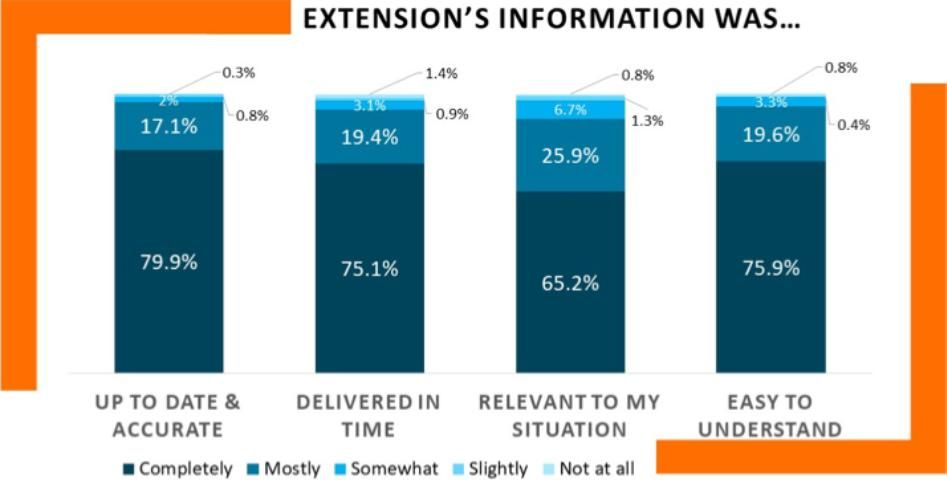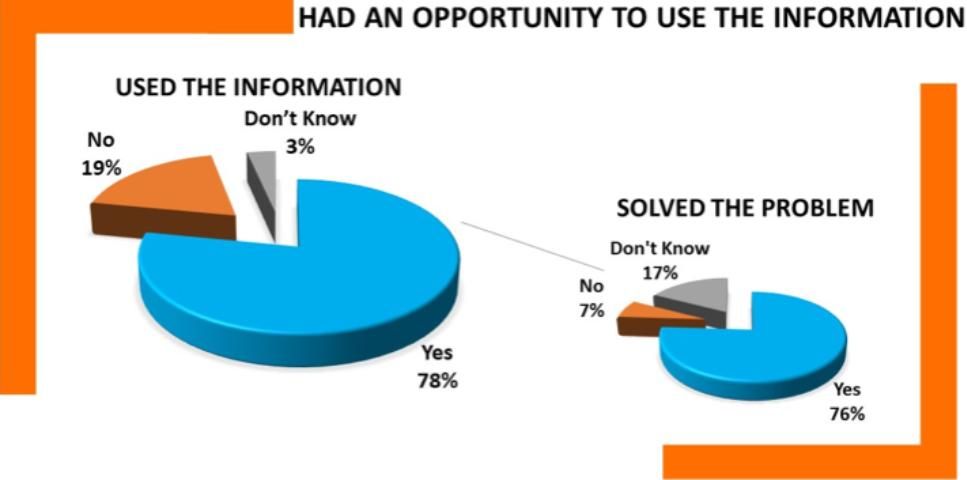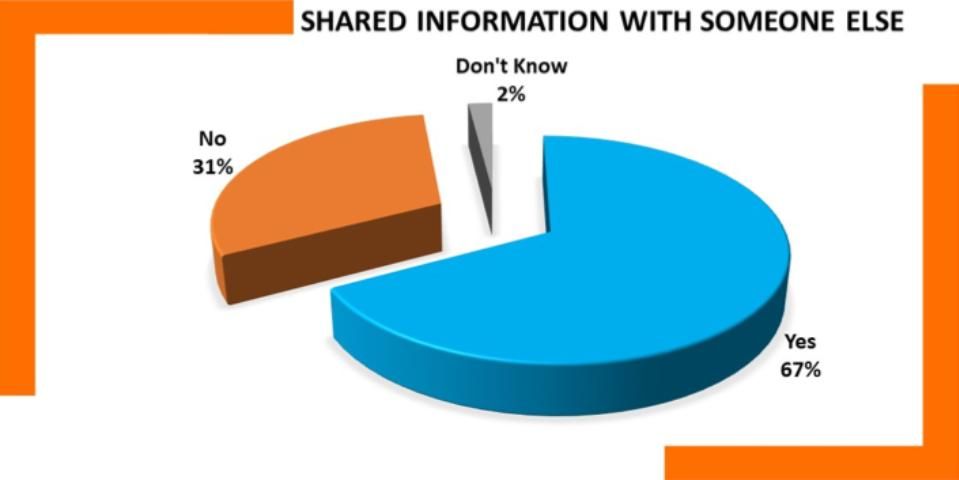Introduction
The Florida Cooperative Extension Service (FCES) conducts nonformal educational programs and responds to inquiries on a variety of topics for residents throughout the state. In 2017, these programs addressed family nutrition and well-being, lawn and garden care, youth development, agricultural production, water conservation and natural resources, and much more. FCES sent a survey to a sample of clients who had attended a workshop or seminar, called the Extension office, or visited the office. A large majority of FCES clients who responded to the survey reported being satisfied or very satisfied with the educational services they received from their county Extension office. Research has shown that clients who have positive interactions with Extension services, are more likely to recommend Extension services to others and develop loyalty to Extension as well (Haile & Israel, 2005; Terry & Israel, 2004). This publication reports a summary of the survey results, along with clients' comments about how they were helped and suggestions for improvement. In addition, recommendations for addressing client suggestions are made.
Use of Extension Services
Many Extension clients utilized services multiple times during 2017, as well as for a number of years before. When Extension clients are satisfied with the services they receive, they are more likely to use Extension services multiple times during a year, and several years after their first encounter with Extension. For example, 21.0% of clients reported utilizing Extension services 3‒4 times in 2017, 11.7% used FCES 5‒9 times, and 10.8% used FCES 10 or more times. Likewise, many clients had long-term relationships, with 21.6% and 19.6% using Extension services for 5‒14 years and 15 or more years, respectively.

Summary of Survey Results
Extension's Information Was...
A set of four questions asked clients about aspects of the quality of service delivery (see Rossi, Lipsey, & Freeman, 2004). Respondents reported very high levels of service quality, with 95.5% of clients reporting the information as mostly or completely easy to understand and 97.0% reporting that the information they received was mostly or completely up to date. For example, one Extension client stated that "... everything [was] up to date and presented in a fun but thorough way, I very much enjoy[ed] the relaxed atmosphere of the classes." In addition, 94.5% of Extension clients reported the information as being mostly or completely delivered in a timely manner, and 91.1% reported the information as being mostly or completely relevant to their personal situation. This was illustrated by one client who reported the "information I request is always helpful and provided in a timely manner."

Opportunity to Apply the Information
At the time of the survey, 78.1% of Extension clients reported that they had an opportunity to use the information from Extension. For example, one client stated that she used the information to "decrease her salt intake by incorporating more fresh herbs and spices into her cooking." Of the clients who used the information, 76.0% reported that it helped solve their problem or answer their question, compared to only 6.7% who reported that using the information did not.

Shared the Information
Two-thirds (67.2%) of respondents reported that they had shared the information with someone else, compared to 30.8% who reported that they did not pass the information along. One client noted that he used the weed eradication information provided by the county Extension office and shared it with private landowners as a part of his job. Similarly, another client reported that she used the information provided to "develop programs for others."

Overall Rating of FCES' Services
A total of 94.9% of Extension clients who used services over the past year reported that they were satisfied or very satisfied with the overall services provided by the county office. For example, one client noted, "I have been pleased with the information and services provide for the last 37 years to me." Another client praised Extension's services, saying that, "...whenever I have called with questions or needing information everyone always bends over backwards to help me." On the other hand, a few (1.1%) clients who used services over the past year reported that they were dissatisfied with the services provided. Comments from these clients indicate that much of the dissatisfaction stems from delays in responding to inquiries or conflicts with the times that educational events are scheduled. This feedback, both positive and negative, can be helpful for working to keep services aligned with client needs.

Benefits from Using Extension Services
As a result of using Extension's services, clients reported the following benefits: 34.3% saved money, 25.6% developed leadership/volunteer skills, 26.1% conserved water/energy, 21.5% improved their health, 7.0% increased income, and 34.6% reported some other benefit. A total of 88.0% benefitted in some way, while 12.0% reported that they received no benefit from the use of Extension services. It is important to note that some clients might not have had an opportunity to put the information they received to use at the time they answered the survey. One client reported, for example, that she was able to save money because, "... I learned how I can look up my credit myself and how to get rid of the things I need to. That information helped me save money and allowed me to do it on my own." Many other clients reported that the information and services provided by Extension have helped to improve the overall health and well-being of their friends, family, and children through small lifestyle modifications, such as decreasing salt intake, increasing exercise, and diabetes management.

Suggestions for Improving Services...
Despite the large percentage of clients who rated Extension's services in a very positive way, nearly two-thirds had suggestions on how Extension might improve services for themselves and others. These suggestions represent both a challenge and an opportunity for FCES in meeting residents' educational needs in the decades to come. Moreover, a number of these were similar to ones made in previous surveys. In 2004, for example, some clients suggested offering additional programs to include more topics, offering more Saturday classes, and increasing the availability of educational programs. They also suggested more advertising such as in local newspapers, schools, and public libraries (Haile & Israel, 2004). In 2017, Extension clients made a number of the same suggestions as did clients thirteen years ago, including improved communication, increased advertising, and expanded class availability. Class availability elicited a large number of comments for improvement. Clients suggested that Extension offer more classes in the afternoons, along with classes on Saturday's.
One new topic for improvement in 2017 concerned information on websites. One client suggested developing an interactive, web-based diagnostic tool for common gardening and landscaping problems and creating 2- or 3-minute instructional videos for common topics. Another common suggestion was to advertise through social media (i.e. Facebook, Instagram, Twitter, etc.), which would address the comment by many clients that services offered through Extension were not well known and could be advertised more. One client also suggested developing a mobile app that consisted of the two features mentioned above (diagnostic tools and instructional videos), but also consisted of updates, class schedules, and announcements.
Another concern involved obtaining CEUs, as many clients reported classes that provided CEUs either filled up quickly or were being offered at less-than-attractive times. One client also reported that, "UF has had the same pesticide show for over ten years," and, consequently, there is a need to critically review presentations to ensure they are completely up to date. Several clients also suggested offering seasonal information and being more attentive to smaller farmers and gardeners. Some clients felt as though the information received was geared more towards large-scale commercial farmers/gardeners, rather than backyard gardeners/farmers. Although most survey respondents were overall satisfied with the services received, it is important to take these suggestions for improvement into consideration, since many mirror recommendations from thirteen years ago.
Recommendations
The numerous suggestions about how county Extension offices could improve their services leads to recommendations for professional development on techniques for enhancing service quality and expanding programmatic opportunities, as well as organizational-level adjustments that increase the capacity to reach more potential clients within the constraints of limited resources.
In order to address clients' concerns about enhancing service quality, professional development opportunities for county faculty should incorporate training to improve communication with clients. Such training, for instance, could emphasize strategies for responding to emails in a timely manner, making bilingual materials readily available, and taking sensory impairments into account during planning for educational events (i.e., hearing, vision, disability, etc.; see Stofer, 2018). Other professional development might focus on creating online resources and instructional programs, as well as using social media for communicating educational opportunities to the public (although a number of county faculty are already engaged in these efforts, their colleagues need support in this area). Social media advertising has been shown to reach a large number of people for a small amount of money and time (see Israel et al., 2015).
Extension administrators can support county faculty through organization-level change that provides critical staff, tools, and expertise. This might include creating repositories of educational materials (e.g., instructional videos, decision tools, active learning protocols, marketing posters, etc.) that organize the large volume of existing material and add a new dimension to the existing EDIS publications system.
In addition, leadership is needed to cultivate a culture of change that results in more opportunities for Florida's residents to participate in educational programming in their preferred modalities. Current efforts encouraging faculty to develop online educational resources that can be used and reused is a good step. Given the large amount of effort going into developing educational resources and implementing programs, it will be important to synthesize these efforts with an eye toward designing integrated, multimodal educational programs that create widespread awareness and enhance participation.
Conclusion
Based on survey results, it is clear that Extension has been meeting expectations about services for the majority of clients in Florida. This high level of client satisfaction has been documented over many years (Israel & Fugate, 2001; Haile & Israel, 2005). Many clients report having a high level of satisfaction with the services provided and programs available and speak highly of Extension staff. However, it is important to take into consideration the various suggestions for areas to make improvements. It is noteworthy that some of the same suggestions for improvement from thirteen years ago are still very much issues today, which suggests the difficulty in resolving these. Perhaps one place to begin to show improvements is the increased use of technology. In an increasingly digital world, online advertising, notifications, and the development of mobile applications can be a cost-effective way to reach clients and, in turn, increase the overall satisfaction.
A Note about Survey Procedures
The Florida Cooperative Extension Service conducts an annual survey to assess the level of client satisfaction. The survey was sent to a sample of clients who have received educational information between March and July, 2017. The survey is conducted by email or postal mail (see Israel, 2017, for details about the survey protocol). The questionnaire contains a set of items including questions related to experience in obtaining information, overall satisfaction, use of Extension's services, suggestions for improvement, and respondent demographics. A total of 1,214 clients responded to the survey, which is a response rate of 47.5% (RR2; AAPOR, 2016). The data were analyzed using SAS and NVivo software packages.
References
American Association for Public Opinion Research [AAPOR]. 2016. Standard Definitions: Final Dispositions of Case Codes and Outcome Rates for Surveys. Retrieved from https://www.aapor.org/AAPOR_Main/media/publications/Standard-Definitions20169theditionfinal.pdf
Haile, T. M. & Israel, G. D. 2005. A Job Well Done: Clients Satisfied with Extension's Service. AEC374. Gainesville: University of Florida Institute of Food and Agricultural Sciences. https://edis.ifas.ufl.edu/wc056
Israel, G. D. 2017. Florida Cooperative Extension Service's Customer Satisfaction Survey Protocol. Retrieved from https://pdec.ifas.ufl.edu/satisfaction/CSS%20Protocol%20-%202018.pdf
Israel, G. D., & Fugate, A. M. 2001. Extension Helps Residents; Customer Satisfaction High. AEC342. Gainesville: University of Florida Institute of Food and Agricultural Sciences. https://edis.ifas.ufl.edu/PD040
Israel, G. D., Borger, R. H., Greer, K., Kelly, S., Byrum, K. L., Pelham, J., Samuel, N., Singleton, L. O., Wells, II, R. H., & Momol, T. 2015. "Using Facebook Advertising to Connect with Extension Audiences." Journal of Extension, 53(4), article 4FEA10. https://archives.joe.org/joe/2015august/a10.php
Rossi, P. M., Lipsey, M. W., & Freeman, H. E. 2004. Evaluation: A Systematic Approach. 7th ed. Newberry Park, CA: Sage Publications.
Stofer, K. 2018. Getting Engaged: Program and Event Planning for Clients with Diverse Abilities. AEC636. Gainesville: University of Florida Institute of Food and Agricultural Sciences. https://edis.ifas.ufl.edu/publication/wc299
Terry, B. D., & Israel, G. D. 2004. "Agent Performance and Consumer Satisfaction." Journal of Extension, 42(6). https://archives.joe.org/joe/2004december/a4.php